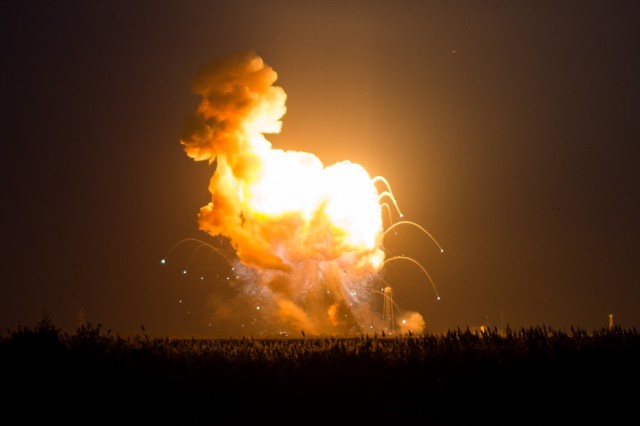
Antares explodes following a loss of thrust – Photo: NASA
The last week of October, 2014 was not a good one for commercial space flight. The week started with Orbital Sciences (OSC) attempting to launch their Antares rocket, carrying their unmanned Cygnus cargo vessel to the International Space Station. After a cancelled launch on Monday for a boat in the safety zone, the second attempt on Tuesday ended in failure.
Seven seconds after liftoff, a catastrophic failure in one or both of the engines caused the rocket to lose all thrust and fall back onto the launch pad, with a large explosion. OSC had launched the Antares four times previously with success, three of those times carrying a Cygnus craft. The company has been a major player in the spaceflight industry for over 30 years, having proven themselves with their unique Pegasus rocket, and a wide range of commercial satellites that they produce for various customers.
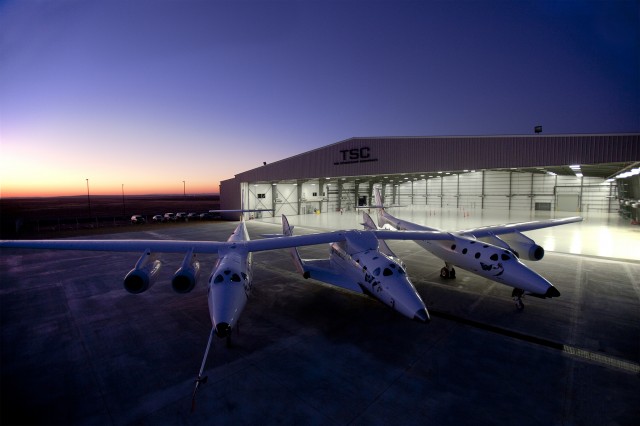
WhiteKnightTwo and SpaceShipTwo togther – Photo: Virgin Galactic
With the failure of the Antares still fresh in everyone’s mind, on the following Friday, Virgin Galactic prepared for a test flight of their private space passenger vehicle, SpaceShipTwo. Shortly after 10:00AM PST, Virgin sent out a cryptic tweet: “#SpaceShipTwo has experienced an in-flight anomaly.” That anomaly turned out to be a worst-case scenario, with the craft breaking up 55,000 ft above the Mojave Desert for still-unkown reasons. With one pilot in serious condition, the other was not as lucky. Mark Alsbury was the latest test pilot to pay the ultimate sacrifice in the pursuit of pushing aviation to the limits. Over the past 70 years, hundreds of brave pilots gave their all for the same purpose, and it has not been in vain.
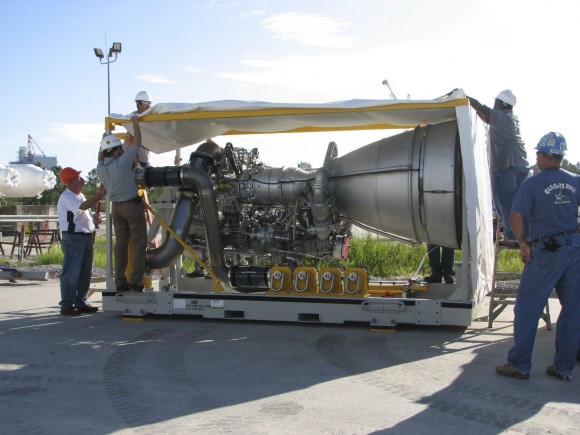
Kuznetsov NK-33 – Photo: Aerojet
While these are two completely different programs, and are not technically associated in any way, they do have one thing in common: private space travel. After the Antares rocket crashed at the Wallop’s Island launch facility on October 28th, speculation immediately began focusing on Orbital’s choice of 45-year-old Soviet-era engines to power the rocket. The Kuznetsov NK-33 engine was originally developed for the failed N1 rocket, the Soviet attempt at landing a man on the moon. Following the collapse of the Soviet Union, a stash of 150 NK-33s were discovered in a warehouse in Russia, and Aerojet acquired and imported a minimum of 36 engines for refurbishment and modernization. Orbital has stated in the past that they would like to replace the elderly engines with more modern, western, engines; however, nothing in the thrust range was available at the time.
Troubles with the NK-33 have plagued Orbital. On two separate occasions, once in 2011, and again in May 2014, a NK-33 failed on the test stand. In the 2014 test, the engine exploded with enough force to cause major damage to the test stand, rendering it unusable for over six months. The spectacular failure of Antares brought into question the judgment of NASA contracting out the resupply of the space station to private companies. However, this program has proven itself to date. With SpaceX performing five successful missions to the station, and Orbital having flown three, there is no reason to believe that commercial resupply missions are a bad idea.
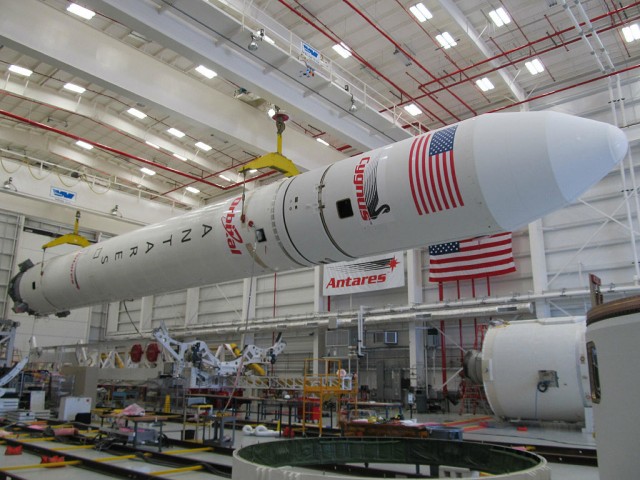
Antares Rocket seen in horizontal position – Photo: Craigboy | Wiki Commons
The idea of private space travel has been a dream of many since the dawn of the space age. With the advent of the X Prize, a new wave of people found interest in spaceflight, and a sort of mini-resurgence was born. During the time leading up to Mojave Aerospace Ventures winning the Ansari X Prize, up to 20 groups were actively competing for the $10 million purse. Each team had a different idea how to go about it, and we saw a surge in interest for space.
We need that in this day and age. Ever since the late 1960’s, before Apollo 11 even landed on the moon, Congress cut NASA’s funding. Ever since 1966, NASA’s budget has been one of the lowest of all government agencies, and in 2013, it was at the lowest it has ever been since the creation of the agency in 1958. According to space analyst and writer Dennis Wingo:
“There is a huge problem that we have today and that is the lack of vision and forward thinking in leadership positions in government. In the late 1960’s, even before the first man walked on the Moon, congress and the white house (sic) cut the funding for the Apollo program sufficient to end the production of the Saturn V. The excuse of the day was deficits, but that is a laugh when the deficit that year was $5 billion dollars. The truth is the money was redirected due to the fear that captured the political elite of the era in control of the government due to the Vietnam war and the problems in our inner cities.
This redirection was not just from NASA’s budget, it affected basically all advanced technology development that the WWII generation put into play in the 50’s and early 60’s. Government advanced technology development has never really recovered. Politicians soon figured out that this redirected money bought votes, and thus piled on more, and have done so for the last 47 years. Today American federal policy is little more than figuring out new programs that will enable the buying of even more votes.
You need look no farther than the space program since then for evidence of this. While the vote buying budget increased by orders of magnitude, space exploration and advanced technology funding has continually shrunk as a proportion of the federal budget.”
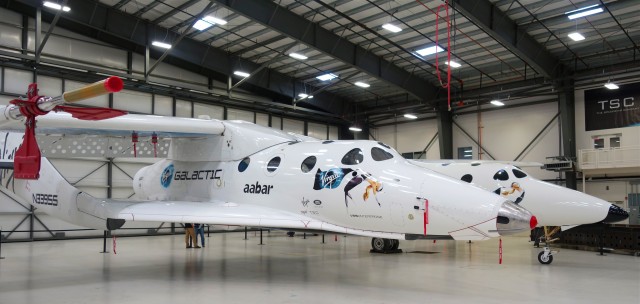
SpaceShipTwo in better days. Photo: Steve Jurvetson | Flickr CC
With a lack of support from our government and elected officials, we need the private sector to fill in these gaps. To borrow a line from the 1983 movie The Right Stuff, ’œNo bucks, no Buck Rogers.’ Without men like Burt Rutan, the legendary and visionary aircraft designer who designed SpaceShipOne and SpaceShipTwo, as well as backers like Paul Allen, who funded SS1, where would we be today?
Yes, the accident on October 31st probably would not have happened, nor would have the accident on a test stand in 2007 that killed three of Scaled Composites’ employees. However, it’s because of men like these, and their entire team of dedicated engineers, builders, and pilots who are willing to risk it all, and even pay the ultimate sacrifice in the name of furthering our exploration of space, that we are where we are.
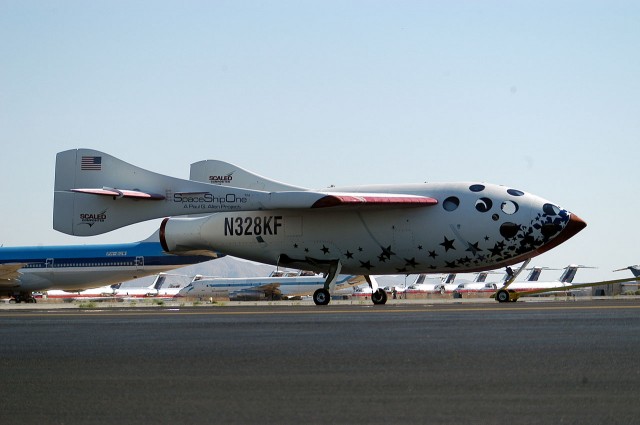
Here is Scaled Composites SpaceShipOne – Photo: WPPilot | Wiki Commons
In the days following the crash of SpaceShipTwo, Richard Branson has been in the hot seat. To his credit, he dropped everything in England and headed immediately to Mojave to be on-site. When he gave a short press conference on Saturday, November 1st, he was not his usual flamboyant self. For most, it was the first time they had seen the man visibly solemn and emotional. He mentioned in his brief speech:
’œWe are determined to find out what went wrong and are working with the authorities to get that information. It is too early for me to add any details of the investigation at this stage. We’ve always known that commercial space travel is an incredibly hard project. We’ve been undertaking a comprehensive testing program for many years and safety has always been our number one priority. This is the biggest test program ever carried out in commercial aviation history to ensure that this never happens to the public’¦’
’œ’¦We do understand the risks involved, and we’re not going to push on blindly – to do so would be an insult to all those affected by this tragedy. We’re going to learn from what went wrong, discover how we can improve safety and performance, and then move forward together. I truly believe that humanity’s greatest achievements come out of our greatest pain. This team is a group of the bravest, the brightest, the most determined, and the most resilient of people. We are determined to honor the bravery of the pilots and the teams here by learning from this tragedy. Only then can we move forward united behind a collective desire to push the boundaries of human endeavor.’
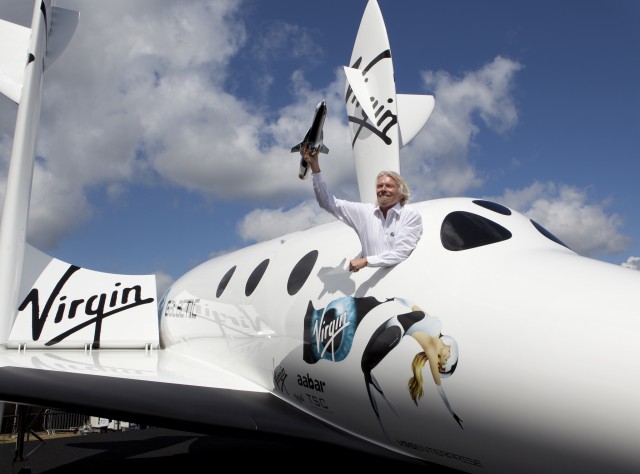
Sir Richard Branson showing off his space machines – Photo: Virgin Galactic
Many in the media and industry have criticized Branson and Virgin Galactic over their management of the program. One of the biggest criticisms has been about safety, and that should be rightfully so. However, spaceflight is inherently dangerous, no matter how routine it becomes – just like driving your car is inherently dangerous. The test pilots that have flown and put SpaceShipTwo through its paces knew the risks that they faced, and every time they strapped into an experimental aircraft, there is always the thought in the back of their mind that this could be the last time their feet touch the ground, the last time they see their families. Safety has always been a paramount concern in aviation and space flight, and it was one thing that Rutan was and is known for.
It is understandable that there are people out there who are critical of Virgin Galactic’s handling of the whole approach to private spaceflight, and they have their place. In the aftermaths of Apollo 1, Challenger, and Columbia, we saw the same criticism. Is it just? Probably. But to call for a project to be terminated because of these issues is absurd. The issues need to be seriously looked at, analyzed, and dealt with, if possible. One of the most criticized elements of the project has been its engine.
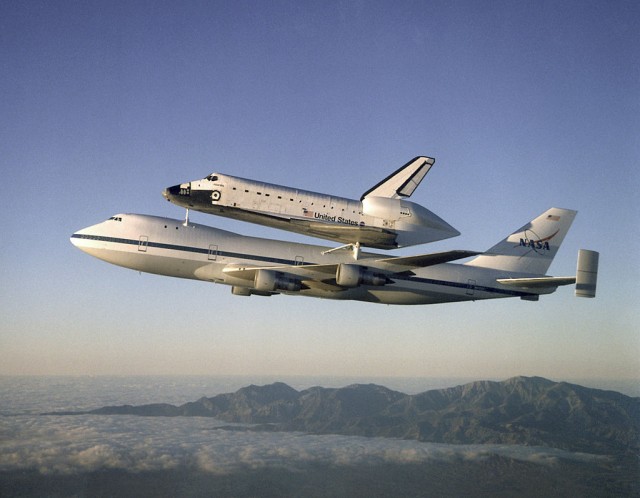
The Space Shuttle Atlantis on the Shuttle Carrier – Photo: Dbenbenn | Wiki Commons
Using the same type of engine as was featured in SS1, SS2 was built around a hybrid rocket motor. In a hybrid, a solid fuel source and a liquid oxidizer (in this case HTPB rubber and nitrous oxide) are combined to propel the craft. Until SS1 first flew, hybrids were relegated to hobby and small research rockets. However, scaling up the engine to the larger size for SS2 presented problems. The rubber fuel did not burn smoothly, and caused severe vibrations.
In 2007, the aforementioned accident took place during a “cold flow” test of the engine. The nitrous oxide tank ruptured with catastrophic results, killing three Scaled employees. During the first three powered flights of SS2, there were serious engine issues, and the choice was made in May 2014 to switch from a rubber fuel to a plastic one. The accident flight was to be the first flight with the new engine. Hybrids are known across hobby rocketry circles as being cantankerous, so why did Rutan chose this engine to begin with? According to aviation journalist Stephen Trimble:
“Rutan saw liquid rockets as unnecessarily complex and potentially dangerous, so he was determined to use a solid fuel propellant, and he persuaded pretty much all of us back in 2004 that it would work, at least for SpaceShipOne. On SpaceShipTwo, it was more or less quickly discovered that a rubber-based solid fuel was too unstable, and the nitrous oxide that Rutan thought was so safe was actually quite dangerous. That should have forced them to go back to the drawing board. Instead, they chose to switch to a plastic-based solid fuel, even though there is much skepticism such a fuel is energetic enough to get SpaceShipTwo out of the atmosphere. The explosion we saw on Friday may have had nothing to do with the new propellant. It might be a flaw in the nitrous oxide system. Or something else completely.”
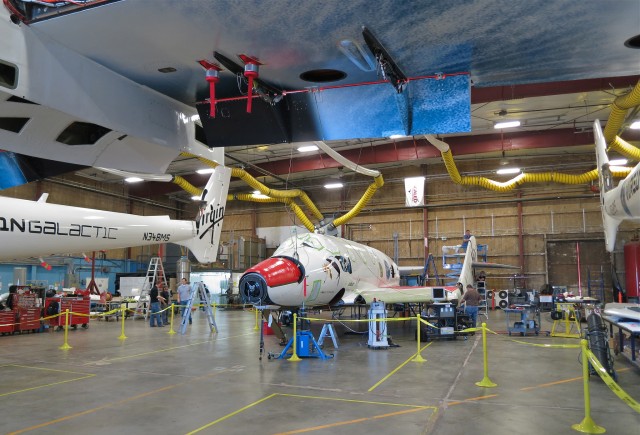
Scaled Composites’ SpaceShip Two Under Construction – Photo: Steve Jurvetson | Flickr CC
These engine issues are serious, however. While at this time it is looking like the engine was not a major factor in the incident (unconfirmed, as the investigation is just beginning.), the concerns that many have with the propulsion system are noteworthy, and need to be looked at seriously. Brian Binnie, who piloted the second X Prize flight in SS1, left Scaled Composites and joined the staff of XCOR, a Mojave-based competitor. In a talk he gave at the Explorer’s Club in New York on October 25th, 2014, Binnie explained that he left because he felt he had run his course with SS2, and that in his mind, after ten years of development the engine was not going to work.
He went on to explain that you built an aircraft around an engine, not the other way around, and that is the way SS2 is being developed. Along with Binnie’s misgiving and concerns, there are many other employees, both current and former, who have expressed concerns of the whole nature of the program. When a project leader and many top employees start questioning a design, maybe it is time to take a serious look at what is going on, and how it can be fixed.
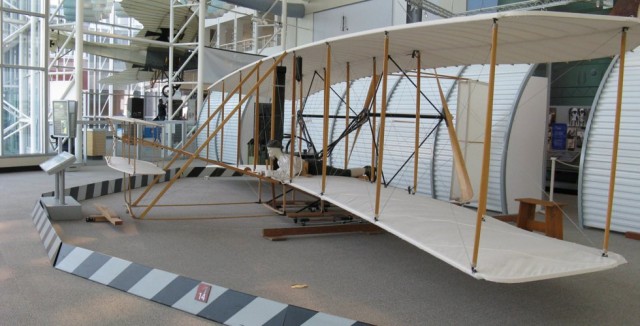
Wright Flyer Replica – Photo: Museum of Flight
On September 17th, 1908, Orville Wright was flying a demonstration flight for the US Army Signal Corps with Lt. Thomas Selfridge on board as an official observer. Wright lost control of the flyer after a propeller split, and the plane crashed from an altitude of roughly 100ft. Selfridge became the first casualty of aviation on that day. What would the world we live in today be like if people gave up right then and there? Would we have global travel? Another common complaint coming out of SS2’s crash is that Virgin Galactic is catering to the 1%, that it is ’œan expensive roller coaster ride for the rich,’ as one writer for Wired Magazine put it. In the early days of air travel, it was the same case. Without people like Richard Branson funding projects like Virgin Galactic, where would we be?
So, what do these two incidents in the week have to do with each other? They are a reminder that the pursuit of space travel is not to be taken lightly, but it needs to be pursued, we must continue mankind’s voyage off of the Earth and continue to reach out and explore in the spirit of those who have gone before us. Branson was asked a very poignant question in his press conference:
’œDoes the dream live on?’ His reply: ’œIt’s fair to say that all 400 engineers who work here and I think most people in the world would love to see the dream living on. As I say that we owe it to our test pilots to find out exactly what went wrong, and once we’ve found out what went wrong, if we can overcome it, we’ll make absolutely certain that the dream lives on.’
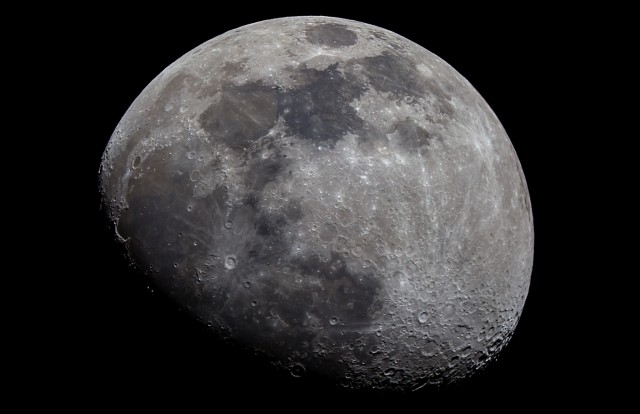
Space — a good place to check out – Photo: Stephen Rahn | Flickr CC
If Virgin Galactic does fold, and it is in the opinion of this writer that it is a strong possibility, they cannot be the end of this pursuit. We need to give our support to the other companies and endeavors that are striving to make space travel available to the common man. President John F. Kennedy’s words from his September 1962 speech at Rice University ring truer today than they have since he said them on that day:
’œWe set sail on this new sea because there is new knowledge to be gained, and new rights to be won, and they must be won and used for the progress of all people. For space science, like nuclear science and all technology, has no conscience of its own. Whether it will become a force for good or ill depends on man, and only if the United States occupies a position of pre-eminence can we help decide whether this new ocean will be a sea of peace or a new terrifying theater of war. I do not say the we should or will go unprotected against the hostile misuse of space any more than we go unprotected against the hostile use of land or sea, but I do say that space can be explored and mastered without feeding the fires of war, without repeating the mistakes that man has made in extending his writ around this globe of ours.
There is no strife, no prejudice, no national conflict in outer space as yet. Its hazards are hostile to us all. Its conquest deserves the best of all mankind, and its opportunity for peaceful cooperation many never come again. But why, some say, the moon? Why choose this as our goal? And they may well ask why climb the highest mountain? Why, 35 years ago, fly the Atlantic? Why does Rice play Texas?
We choose to go to the moon. We choose to go to the moon in this decade and do the other things, not because they are easy, but because they are hard, because that goal will serve to organize and measure the best of our energies and skills, because that challenge is one that we are willing to accept, one we are unwilling to postpone, and one which we intend to win, and the others, too.’
PER ASPERA AD ASTRA – through hardships to the stars!
A very good review of a very bad week for commercial space….and we must continue to explore.